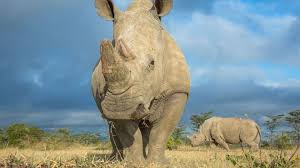The sixth mass extinction is here, and unlike previous ones, this has little to do with high volcanic activity or an asteroid hitting the Earth. Instead, the two biggest drivers of the Holocene (as it is also known), are largely man-driven: deforestation and climate change (Woodward, 2019). Deforestation destroys many species’ habitats, while climate change means that many species have to survive in never before-seen conditions.
The common example given when discussing climate change’s effects on animals is the polar bear: as the sea ice melts, the polar bear faces larger difficulties finding its main prey, the ringed seal (Pidcock, 2015), as it lives on the sea ice edge. There are other, such as the death of the last male northern white rhino in 2018 (Gibbens, 2018). However, technological improvements are deemed promising to tip the scales of the Holocene in favour of species conservation.
Take CRISPR technology, which is extremely precise genetic modification. While this means that theoretically, animals born in captivity could be genetically modified to be able to face harsher conditions (eventually, this technology is not this developed as of yet), this would not tackle the actual drivers of the Holocene. Instead, this technology could be used to create man-made palm oil. The extraction and growth of palm oil is one of the few main drivers of deforestation (Fritts, 2018), and if a man-made, potentially more effective way of growing palm oil was arranged, perhaps this would help lower deforestation, and could help the population of Orangutans in Borneo, which has dramatically decreased by 150,000 in 16 years (Sample, 2018). Similarly, it could be applied to produce man-made ivory, perhaps making rhinos lesser targets. (Pacheco, 2018). Naturally, CRISPR (and other genetic modification technologies) have ethical implications to them.
Another perhaps more attainable technology is the use of AI for conservation programs. These programs require large volumes of data collection, such as medical data, feeding data, sperm counts, among others (Fryer, 2018), to better understand the animal’s lifecycle, sexual cycles, best environment and best potential matches, to continue promoting biodiversity (Fryer, 2018). AI can much more efficiently and quickly handle large volumes of data, and potentially find more hidden patterns. Essentially, AI could not only assist, but enhance the monitoring of data to help conserve biodiversity.
Although these (and other) technologies are great as raw ideas, they have to be embedded together. For example, AI might make data processing quicker, but collecting the data by hand would be extremely time-consuming. Drones on the other hand, could make the process more efficient, as it can also reach the more remote, unreachable areas to study animal patterns, potentially providing richer information.
It is clear to see that technologies definitely have the power to empower humans to preserve biodiversity and prevent the Holocene. However, they still do not truly challenge the real issues of climate change or deforestation, as these depend more heavily on the choices that humans make. On the other hand, I believe these new technologies (and other current ones) are crucial, and will be critical in helping save many of the species that are at risk of extinction in the near future. For example, scientists recently extracted eggs from the two last surviving northern white rhinos, and will use in-vitro fertilization to hopefully keep the species alive (Gilliland, 2019).
References:
Fritts, R. (2018). A New Study Reveals Global Drivers of Deforestation. [online] Pacific Standard. Available at: https://psmag.com/environment/whats-driving-global-deforestation [Accessed 10 Sep. 2019].
Fryer, T. (2018). Conservation technology: can science save endangered species?. [online] Eandt.theiet.org. Available at: https://eandt.theiet.org/content/articles/2018/05/conservation-technology-can-science-save-endangered-species/ [Accessed 10 Sep. 2019].
Gibbens, S. (2018). After Last Male’s Death, Is the Northern White Rhino Doomed?. [online] Nationalgeographic.com. Available at: https://www.nationalgeographic.com/news/2018/03/northern-white-rhino-male-sudan-death-extinction-spd/ [Accessed 10 Sep. 2019].
Gilliland, H. (2019). Bold effort to save rhino completes critical step. [online] Nationalgeographic.com. Available at: https://www.nationalgeographic.com/animals/2019/08/plan-save-northern-white-rhino-ivf/ [Accessed 10 Sep. 2019].
Pacheco, X. (2018). How Technology Can Transform Wildlife Conservation. [online] Available at: https://www.intechopen.com/books/green-technologies-to-improve-the-environment-on-earth/how-technology-can-transform-wildlife-conservation [Accessed 10 Sep. 2019].
Pidcock, R. (2015). Polar bears and climate change: What does the science say? | Carbon Brief. [online] Carbon Brief. Available at: https://www.carbonbrief.org/polar-bears-and-climate-change-what-does-the-science-say [Accessed 10 Sep. 2019].
Sample, I. (2018). Dramatic decline in Borneo’s orangutan population as 150,000 lost in 16 years. [online] the Guardian. Available at: https://www.theguardian.com/environment/2018/feb/15/dramatic-decline-in-borneos-orangutan-population-as-150000-lost-in-16-years [Accessed 10 Sep. 2019].
Woodward, A. (2019). 17 signs we’re in the middle of a 6th mass extinction. [online] Business Insider Nederland. Available at: https://www.businessinsider.nl/signs-of-6th-mass-extinction-2019-3?international=true&r=US [Accessed 10 Sep. 2019].


I found this blog really interesting as it provides a view on how technology can be an alternative solution to save biodiversity.
Do you believe that drones and AI can be combined together to have quantitative and usable information on the habits of animals? For example their sexual cycles. Don’t you think that human manual distinction will still be needed?
It was indeed a very interesting post to read. I am very curious what kind of technologies they can apply on animals, and potentially transfer those to human beings.
In a response to Guillaume, currently drones are used in simple counts and basic behaviours. It even turns out that they are more accurate than wildlife experts (Hodgson, Terauds & Koh, 2018). The focus is now on more complex processes such as the sexual cycles and how drone protocols can assist in this. I believe for these complex behaviours that are hard to observe with techniques such as drones, human distinction is still a necessity.